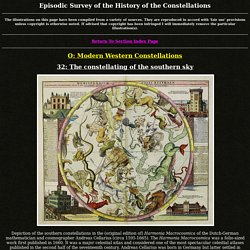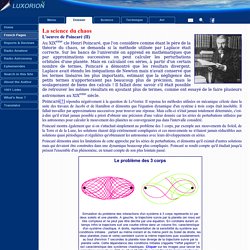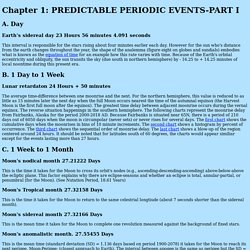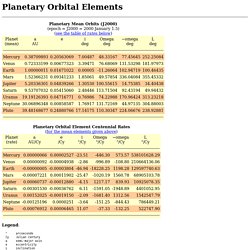

Atlas Coelestis, 1729 - 1729 - Meeteek. Home - Astronomie-rara. Constellations of Words. Star-names and their meanings : Allen, Richard Hinckley, 1838-1908. The United States Naval Observatory Library. Moraine, добро пожаловать! — Последний довод королей. Звездный атлас Александра Джемисона (картинки можно кликать) 1.

Northern Hemisphere 2. Ursa Minor, Cassiopeia, Tarandus, Cepheus, Draco, Custos Messium 3. 4. 5. 6. 7. 8. 9. 10. 11. 12. History of Constellation and Star Names. Episodic Survey of the History of the Constellations The illustrations on this page have been compiled from a variety of sources.

They are reproduced in accord with 'fair use' provisions unless copyright is otherwise noted. If advised that copyright has been infringed I will immediately remove the particular illustration(s). Return To Section Index Page O: Modern Western Constellations 32: The constellating of the southern sky Depiction of the southern constellations in the (original edition of) Harmonia Macrocosmica of the Dutch-German mathematician and cosmographer Andreas Cellarius (circa 1595-1665).
The southern hemisphere is "richer" in stars and apparent star configurations than the northern hemisphere. The charting of the Southern Hemisphere created the need for new constellations. The process of constellating the southern celestial sky was begun by Petrus Plancius (Dutch: Pieter Platvoet) (1552-1622). Appendix 1: The Southern Cross (Crux) See: Dekker, Elly (1990). Constellations anciennes disparues.
Ch3 alignements planetaires. Jusatocc. Occultation of Saturn by Jupiter are very rare events to be seen from Earth.

Their average frequency is about one in 4000 years, and our present epoch is particularly "empty" of them. None has ever happened during historical times and the next one will be in y 7541. But if mankind will not be extinct (and I won't bet ten cents on that) people will have the extraordinary opportunity to see two such occultations in the same year! Something which is probably not going to happen again in a million years or so!... Below is a list of the 42 occultations occurring between 80000 BC and 80000 AD, sorted in descending order. Les Prochains Evénements rares. Le chaos dans le système solaire. La science du chaos L'oeuvre de Poincaré (II) Au XIXeme cle Henri Poincaré, que l'on considère comme étant le père de la théorie du chaos, se demanda si la méthode utilisée par Laplace était correcte.

Sur les bancs de l'université on apprend en mathématiques que par approximations successives on peut calculer les perturbations orbitales d'une planète. Mais en calculant ces séries, à partir d'un certain nombre de termes, Poincaré a démontré que les résultats divergent. Laplace avait étendu les inéquations de Newton mais n'avait conservé que les termes linéaires les plus importants, estimant que la négligence des petits termes n'apporteraient pas beaucoup plus de précision, mais le soulageraient de biens des calculs !
Poincaré répondra négativement à la question de LeVerrier. Poincaré démontra ainsi les limitations de cette approche par les séries de perturbations, et démontra qu'il existait d'autres solutions mais qui devaient être construites dans une dynamique beaucoup plus compliquée. Astro.uni-bonn. Glorious events that already happened Where: Area(s) of best visibility Next: In how many years does the same or a similar event take place?

References: Key web links or other references Also check M. Peuschel's event listings! The listed events are mostly alignments, conjunctions, transits, occultations and eclipses, involving two or more solar system bodies - and they are so rare that they happen on average less than once per decade. Chapter 1: PREDICTABLE PERIODIC EVENTS-PART I. A.

Day Earth's sidereal day 23 Hours 56 minutes 4.091 seconds This interval is responsible for the stars rising about four minutes earlier each day. However for the sun who's distance from the earth changes throughout the year, the shape of the analemma (figure eight on globes and sundials) embodies what is known as the equation of time for an example how this rate varies with time. Because of the Earth's orbital eccentricity and obliquity, the sun transits the sky (due south in northern hemisphere) by - 16.25 to + 14.25 minutes of local noontime during this present era.
Planetary Orbital Elements. Legend: " arcseconds Cy Julian century a semi-major axis e eccentricity i inclination Omega longitude of the ascending node ~omega longitude of perihelion L mean longitude Notes: This table contains mean orbit solutions from a 250 yr. least squares fit of the DE 200 planetary ephemeris to a Keplerian orbit where each element is allowed to vary linearly with time.

This solution fits the terrestrial planet orbits to ~25" or better, but achieves only ~600" for Saturn.